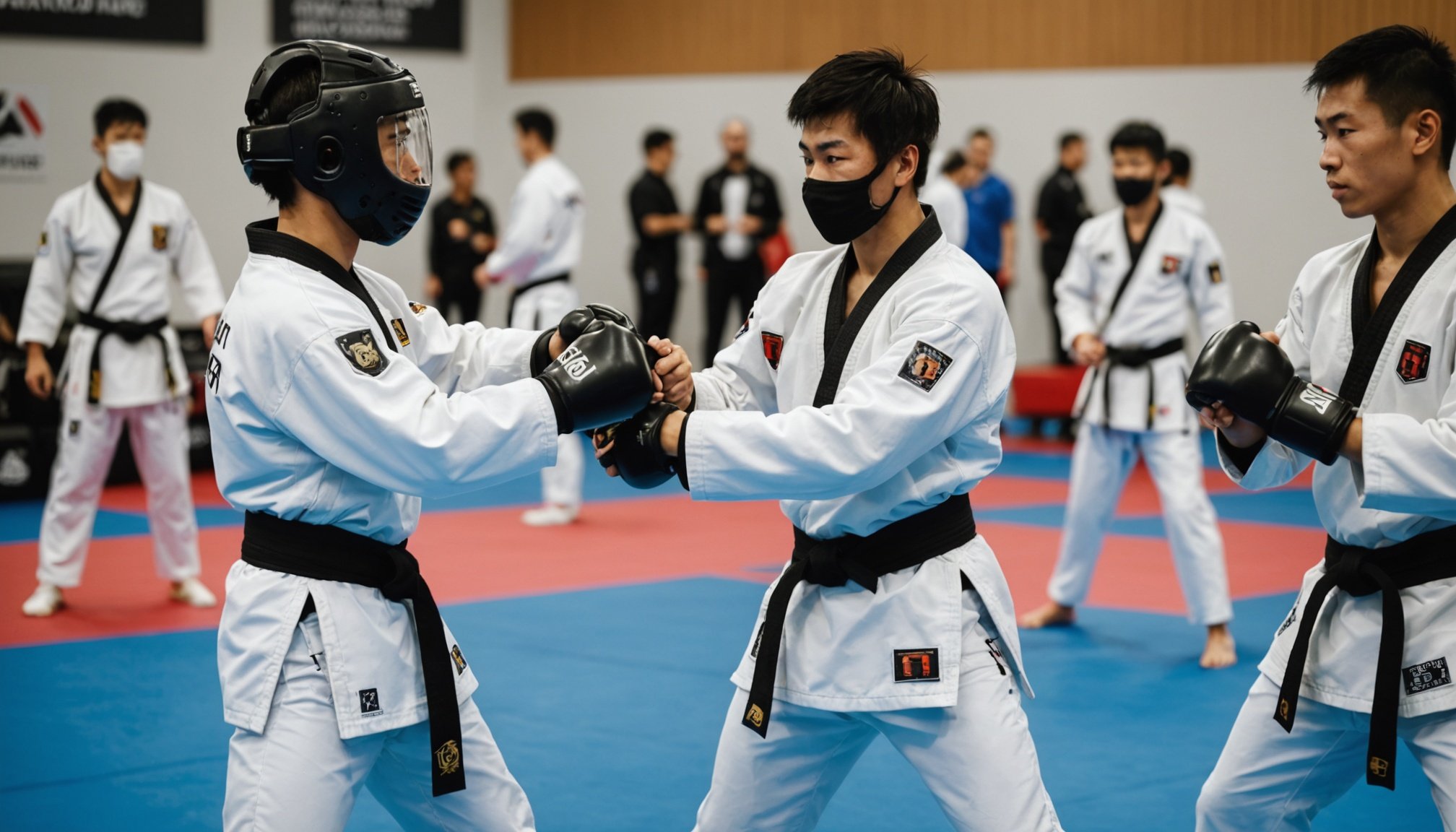Overview of Sparring Safety Protocols in Taekwondo
In Taekwondo, sparring safety is crucial to protect practitioners from potential injuries and to ensure the integrity of the sport. Understanding and implementing Taekwondo protocols are imperative for both students and instructors. These protocols are designed to minimize the inherent risks associated with sparring. UK martial arts safety measures, for instance, often stress the need for comprehensive safety guidelines in training environments.
Sparring can pose various risks, ranging from minor bruises to more severe injuries like concussions or fractures. Recognizing these common risks is the key to crafting effective safety measures. The purpose of establishing robust safety protocols is to reduce these risks, allowing participants to hone their skills in a controlled and secure manner.
In the same genre : Transforming taekwondo training in the uk: innovative uses of video feedback techniques
Safety measures, such as correctly fitted protective gear and adherence to sparring rules, play an important role. By uniformly applying these safety practices, Taekwondo clubs provide an environment where safety and discipline coexist with martial arts philosophy. Emphasizing a safety-first approach during training not only protects practitioners but also fosters a culture of respect and mutual trust. This ensures that the pursuit of excellence in Taekwondo is achieved without compromising the well-being of its enthusiasts.
Legal Regulations and Requirements
In the UK, martial arts regulations play a critical role in maintaining safety during Taekwondo sparring sessions. These regulations ensure that sparring laws are followed diligently by all Taekwondo clubs, which must adhere to established safety standards. Clubs are legally obligated to implement these regulations to protect practitioners from potential harm. Failing to comply can result in legal repercussions, underscoring the importance of understanding and applying these rules within the club setting.
This might interest you : Enhancing fencing excellence: how biomechanical analysis transforms techniques for uk athletes
The legal responsibilities of Taekwondo clubs extend to ensuring that their training environments strictly adhere to regulatory safety standards. This includes having appropriate safety equipment, knowledgeable instructors, and maintaining proper records of incidents and safety assessments. The goal is to create a safe space where practitioners can focus on their skills without excessive risk.
Sparring laws directly influence how sparring safety protocols are formulated and applied. The protocols must align with the legal framework to enhance overall safety and avoid any violations. By complying with these legal requirements, Taekwondo clubs also promote an atmosphere of professionalism, accountability, and trust, which can be beneficial in attracting new members who are keen on a safe training environment. This structured legal foundation ensures the continuity of safe martial arts practices across the UK.
Essential Protective Gear for Sparring
In Taekwondo, protective equipment is more than just an accessory; it is a crucial element in safeguarding practitioners. This gear, specifically designed to absorb impact and prevent injuries, ensures a safe and sustainable training environment.
Importance of Protective Gear
The necessity of Taekwondo gear stems from its ability to mitigate common sparring risks. Properly fitted equipment minimizes injuries, allowing practitioners to focus on technique without compromising safety. Prioritising gear demonstrates a commitment to both individual well-being and the sport’s integrity.
Types of Protective Equipment
Essential items include helmets, body protectors, shin guards, and mouthguards. Each piece plays a vital role, with helmets protecting against head injuries and body protectors cushioning impacts to critical areas. The right selection of safety equipment is pivotal in creating an effective protective barrier.
Maintenance of Equipment
Regular maintenance is key to maximizing gear efficiency. This involves routine checks for wear and tear, ensuring all fastenings are secure, and cleaning items to prevent hygiene issues. Following these practices guarantees that protective gear functions effectively throughout its lifespan. Proper care not only prolongs equipment life but also enhances safety during sparring.
Best Practices for Safe Sparring Sessions
Implementing safe sparring practices is vital for protecting practitioners and maintaining the integrity of Taekwondo. Effective training tips start with setting clear guidelines to ensure a secure environment. This involves adherence to rules, proper use of equipment, and structured sparring sessions to maintain discipline.
Warm-up and cooldown exercises are indispensable in reducing injury risk. Warming up prepares the body by increasing blood flow to muscles, enhancing flexibility and reactivity. Conversely, cooldowns help decrease heart rate gradually and reduce muscle stiffness, contributing to overall safety.
Sparring etiquette is another fundamental component. Encouraging respect and communication among participants fosters a sense of community and trust. This means sharing experiences and ensuring opponents feel comfortable addressing any concerns, which can reduce tension and prevent accidents.
To embed a safety-first approach within a club’s culture, ongoing education and leadership play key roles. Experienced practitioners can offer valuable insights and create an environment where safety is always prioritised. Periodic trainings refresh members’ knowledge and ensure that safety protocols remain a prominent focus, thus promoting a unified martial arts community committed to injury prevention.
Risk Management Strategies
In the realm of Taekwondo, risk management encapsulates the processes of predicting, evaluating, and controlling potential injuries during sparring. Establishing a thorough risk assessment is pivotal before any sparring session to pinpoint hazards that could lead to practitioner injuries. Assessments frequently involve evaluating individual skill levels, experience, and physical conditions to pair practitioners appropriately, crucial in minimizing accidents.
Alongside assessment, comprehensive safety measures form the backbone of risk management. Ensuring protective gear is not just available but used correctly by all participants is essential. The implementation of structured safety protocols is also critical; this includes pre-sparring briefings on rules and techniques and maintaining an instructor-to-student ratio conducive to minimalizing accidents.
Inevitably, executing efficient incident management protocols is vital. Clubs should establish clear steps for addressing injuries: immediate first aid response, evaluation by qualified personnel, and following up with thorough incident reports. Prompt action not only mitigates the severity of injuries but also strengthens the overall safety framework, emphasising a well-rounded approach to risk management as central to safe Taekwondo practice. Such attentive responses cultivate confidence within practitioners, reaffirming the collaborative essence of martial arts where safety is paramount.
Insights from Experienced Practitioners
Gaining wisdom from experienced practitioners can significantly enhance sparring safety. Their valuable practitioner insights stem from real-life experiences, offering a practical perspective on safety measures. For instance, seasoned practitioners often emphasise the importance of expert advice in developing a safety-first mindset. This advice often includes cautious pairing of sparring partners, considering factors like skill level and size, to prevent mismatches that could lead to injuries.
Personal Safety Stories
Narratives of overcoming challenges in sparring provide a compelling backdrop to the importance of safety. Practitioners recount incidents where safety equipment played a pivotal role in preventing serious injuries. These sparring experiences reinforce the critical role that a disciplined approach to equipment maintenance and usage plays in martial arts safety.
Expert Opinions on Sparring Safety
Experts argue that safety should be integrated from the earliest stages of training, with a focus on mastering techniques and sparring etiquette before engaging in higher-intensity practice. Their opinions guide clubs in reinforcing structured protocols, ensuring a balanced emphasis on skills development and injury prevention.
Recommendations for Training
From choosing the right protective gear to maintaining open lines of communication during training, practitioners recommend implementing safety measures diligently. Their collective experiences suggest clubs should regularly revisit and revise safety protocols, ensuring that training environments remain safe and productive for all practitioners.
Incorporating Sparring Safety into Club Culture
Incorporating sparring safety into a Taekwondo club’s culture requires more than just rules; it calls for a safety integration that permeates all levels of practice. Establishing a safety-first mindset begins with clear strategies, woven into the club’s fabric, fostering a martial arts community prioritizing well-being.
Consistency in safety integration is vital. Clubs should strive to make basic safety principles second nature, encouraging practitioners to automatically adhere to protocols without reminders. Developing ongoing education programs is key. These initiatives provide members with regular updates on safety practices, reinforcing their significance. Workshops and seminars led by experienced practitioners deepen understanding and foster a culture of perpetual learning.
Leadership plays a critical role in this process. Club leaders should model appropriate behaviours and proactively address safety concerns. By setting an example, they cultivate an atmosphere of mutual respect and awareness, underscoring the importance of safety.
To promote a cohesive martial arts community, clubs might host events celebrating safety achievements or involve members in generating safety policies. Such engagement strengthens club solidarity, making safety a collective responsibility. This holistic approach not only enhances safety during sparring but also builds a supportive environment that values the well-being of all its members.











